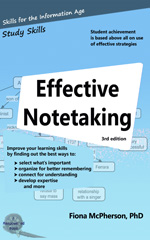Rules for effective note-taking
- Select. Omit trivial and redundant details. Omit anything you'll recall anyway!
- Condense. Replace lists with a category term.
- Organize. Choose headings and topic sentences.
- Rephrase. Use your own words.
- Elaborate. Make connections to existing knowledge.
To use note-taking effectively, you need to understand that its primary value is not in the record you produce, it is in the process itself. The process of taking notes guides the memory codes you make. Note-taking is a strategy for making information meaningful. It is therefore only effective to the extent that you paraphrase, organize and make sense of the information while taking notes.
Note-taking is a strategy for making information meaningful.
What does that mean? What does it mean, to make information meaningful? It means to connect new information to existing knowledge. The more connections you make, the better you will understand the information.
Connection is the heart of what makes information meaningful.
Why is it important to make information meaningful?
Because connection is the key to remembering. The more connections you have, the more entry points you have to the information, therefore the easier it will be to retrieve.
Facts that you already know very well and have no trouble remembering act as anchor points.
The more anchor points you can connect to, the more meaningful the new information becomes, and the more easily you will remember it.
Think about it for a moment. When you are told something new, you only understand it to the extent that you can relate it to something you already know.
Here’s a quote from The complete idiot’s guide to Microsoft Office:
After you select the data source to use, the Mail Merge Helper displays the Label Options dialog box, asking you to specify the type and size of the mailing labels on which you intend to print.
Now if you don’t know anything about computers this will be complete gibberish and there’s no way you’re going to remember it. If you have some experience with Microsoft Office, but have no experience of Mail Merging, then you will sort of understand what’s going on, but not have enough anchor points to really understand it — and you’re not going to remember it either. But if you are already au fait with Mail Merging, and merely want to know how to do the labels, then you will have a well-organized, strong cluster of facts already recorded in memory, and the new fact will slot in easy peasy. You’ll understand it, and you’ll remember it — to the extent that your existing cluster of information about Mail Merging was strong and well-connected.
It’s like learning a new word. Pediment, for example. If you were told this was a triangular part crowning the front of a building in the Grecian style — assuming you don’t already know the word, and assuming you have no particular knowledge of architecture — you’re not likely to remember it without repeatedly coming across it. You might make the connection pediment — impediment, but since there is no meaningful connection between these words, this won’t help you remember the meaning of pediment. It might help you remember the word itself, mind. But to remember the meaning of the word, you need a meaningful connection. That might be provided by the suggestion that pediment is derived from a corruption of pyramid, which as we all know, is triangular, and is also a building.
The more connections to existing anchor points, the more meaningful the word becomes; the more easily remembered it is.
Connection is the key to remembering.
The more connections you have, the more entry points you have to the information.
Therefore, the more easily it will be found.
Connection is the heart of what makes information meaningful.
How does notetaking help make information meaningful?
Here we came to the nub of the matter. Notetaking doesn’t have to make information meaningful, but it is mainly valuable to the extent that it does.
So this is how you judge your notetaking skills, and how you judge the value of a particular strategy in a particular situation —
Ask yourself: does this help me make connections? Does it help me connect the facts together? Does it help me connect the new information with information I already have? Does it make any connection with facts I already know very well, and am unlikely to forget?
Conditions for effective note-taking
- Slow or self-determined rate of presentation
- Well-organized material
- Material that is not too difficult or complicated
- Skill at note-taking1
- Baine, D. 986. Memory and instruction. Englewood Cliffs, NJ: Educational Technology Publications.
- Barnett, J.E., DiVesta, F.J. & Rogozinski, J.T. 1981. What is learned in note-taking. Journal of Educational Psychology, 73, 181-192.
- Peper, R.J. & Mayer, R.E. 1978. Note-taking as a generative activity. Journal of Educational Psychology, 70, 514-522.
- Schneider, W. & Pressley, M. 1989. Memory development between Two and Twenty. New York: Springer-Verlag.
1. Adapted from The Memory Key.
